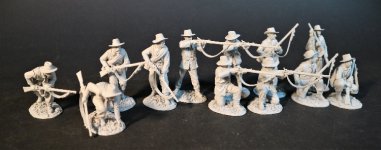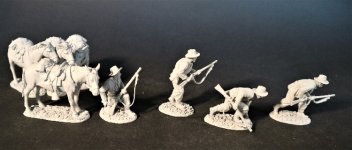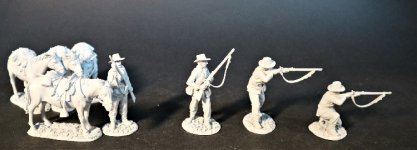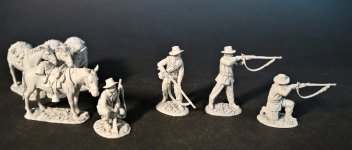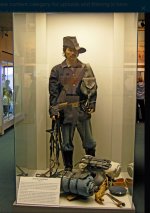mestell
Lieutenant Colonel
- Joined
- Feb 12, 2008
- Messages
- 7,997
Just realized perhaps why Julie hasn't posted John's weekly update yet . . . Returning from CTSS . . . Here it is, I hope you don't mind Julie.
Mike
JJDESIGNS NEWS UPDATE 26th SEPTEMBER 2022
THUNDER ON THE PLAINS
THE BLACK HILL WARS 1876-1877
THE BATTLE OF THE ROSEBUD, 17th JUNE 1876
UNITED STATES INFANTRY
Although the Native Americans hated the US cavalry during the Indian Wars of 1865 through 1891, they learned to respect the infantry.
Crazy Horse called them “Walk-a-Heaps” because they marched into battle.
Duty for the US Army on the frontier consisted mainly of patrolling and small unit actions. For the infantryman this typically involved long, forced marches and counter-marches as they sought contact, which was usually unsuccessful, as the Native Americans were a skilful and elusive foe.
The first day’s march for an infantry column was usually limited to no more than 15 miles in order to give the troops an opportunity to adapt themselves to the conditions. For Campaign seasoned troops, 25 miles was considered a good day’s march.
Cavalry could travel faster and further, but their grain fed mounts tended to tire after days of continual marching and surprisingly, well trained infantry could outdistance cavalry units over a period of several weeks.
PICTURE ATTACHED IN SEPARATE E-MAIL(ROSE01)
On 28th May 1876, Brigadier General George Crook assumed direct command of the Bighorn and Yellowstone Expedition at Fort Fetterman. Crook had gathered a strong force. Leaving Fort Fetterman on 29th May the 1,051man column consisted of 15 companies from the 2nd and 3rd Cavalry, 5 companies from the 4th and 9th Infantry, 250 mules and 106 wagons.
On the 14th June, the column was joined by 261 Shoshone and Crow allies.
Based on intelligence reports Crook ordered his entire force to prepare for a quick march. Each man was to carry only 1 blanket, 100 rounds of ammunition, and 4 days rations. The wagon train would be left at Goose Creek, and the infantry would be mounted on the pack mules.
PICTURE ATTACHED IN SEPARATE E-MAIL(ROSE02)
On 17 June, Crook's column set out at 0600, marching northward along the south fork of Rosebud Creek. The Crow and Shoshone scouts were particularly apprehensive. Although the column had not yet encountered any sign of Indians, the scouts seemed to sense their presence. The soldiers, particularly the mule-riding infantry, seemed fatigued from the early start and the previous day's 35-mile (56 km) march. Accordingly, Crook stopped to rest his men and animals at 0800. Although he was deep in hostile territory, Crook made no special dispositions for defense. His troops halted in their marching order. The Cavalry battalions led the column, followed by the battalion of mule-borne foot soldiers, and a provisional company of civilian miners and packers brought up the rear.
PICTURE ATTACHED IN SEPARATE E-MAIL(ROSE03)
The Crow and Shoshone scouts remained alert while the soldiers rested. Several minutes later, the soldiers heard the sound of intermittent gunfire coming from the bluffs to the north. As the intensity of fire increased, a scout rushed into the camp shouting, "Lakota, Lakota!" The Battle of the Rosebud had started. By 0830, the Sioux and Cheyenne had hotly engaged Crook's Indian allies on the high ground north of the main body. Heavily outnumbered, the Crow and Shoshone scouts fell back toward the camp, but their fighting withdrawal gave Crook time to deploy his forces. Rapidly firing soldiers drove off the attackers but used up much of the ammunition meant for use later in the campaign. Low on ammunition and with numerous wounded, the General returned to his post.
PICTURE ATTACHED IN SEPARATE E-MAIL(ROSE04)
Historians debate whether Crook’s pressing on could have prevented the killing of the five companies of the 7th Cavalry Regiment led by George Armstrong Custer at the Battle of the Little Bighorn.
The Sioux troubles increased the need for mounted troops on the frontier, and as early as December 6th 1866, elements of the 18th Infantry were mounted, and operating alongside Cavalry.
The practice of using mounted infantry continued until the end of the Indian wars.
Best wishes and many thanks
john jenkins
Mike
JJDESIGNS NEWS UPDATE 26th SEPTEMBER 2022
THUNDER ON THE PLAINS
THE BLACK HILL WARS 1876-1877
THE BATTLE OF THE ROSEBUD, 17th JUNE 1876
UNITED STATES INFANTRY
Although the Native Americans hated the US cavalry during the Indian Wars of 1865 through 1891, they learned to respect the infantry.
Crazy Horse called them “Walk-a-Heaps” because they marched into battle.
Duty for the US Army on the frontier consisted mainly of patrolling and small unit actions. For the infantryman this typically involved long, forced marches and counter-marches as they sought contact, which was usually unsuccessful, as the Native Americans were a skilful and elusive foe.
The first day’s march for an infantry column was usually limited to no more than 15 miles in order to give the troops an opportunity to adapt themselves to the conditions. For Campaign seasoned troops, 25 miles was considered a good day’s march.
Cavalry could travel faster and further, but their grain fed mounts tended to tire after days of continual marching and surprisingly, well trained infantry could outdistance cavalry units over a period of several weeks.
PICTURE ATTACHED IN SEPARATE E-MAIL(ROSE01)
On 28th May 1876, Brigadier General George Crook assumed direct command of the Bighorn and Yellowstone Expedition at Fort Fetterman. Crook had gathered a strong force. Leaving Fort Fetterman on 29th May the 1,051man column consisted of 15 companies from the 2nd and 3rd Cavalry, 5 companies from the 4th and 9th Infantry, 250 mules and 106 wagons.
On the 14th June, the column was joined by 261 Shoshone and Crow allies.
Based on intelligence reports Crook ordered his entire force to prepare for a quick march. Each man was to carry only 1 blanket, 100 rounds of ammunition, and 4 days rations. The wagon train would be left at Goose Creek, and the infantry would be mounted on the pack mules.
PICTURE ATTACHED IN SEPARATE E-MAIL(ROSE02)
On 17 June, Crook's column set out at 0600, marching northward along the south fork of Rosebud Creek. The Crow and Shoshone scouts were particularly apprehensive. Although the column had not yet encountered any sign of Indians, the scouts seemed to sense their presence. The soldiers, particularly the mule-riding infantry, seemed fatigued from the early start and the previous day's 35-mile (56 km) march. Accordingly, Crook stopped to rest his men and animals at 0800. Although he was deep in hostile territory, Crook made no special dispositions for defense. His troops halted in their marching order. The Cavalry battalions led the column, followed by the battalion of mule-borne foot soldiers, and a provisional company of civilian miners and packers brought up the rear.
PICTURE ATTACHED IN SEPARATE E-MAIL(ROSE03)
The Crow and Shoshone scouts remained alert while the soldiers rested. Several minutes later, the soldiers heard the sound of intermittent gunfire coming from the bluffs to the north. As the intensity of fire increased, a scout rushed into the camp shouting, "Lakota, Lakota!" The Battle of the Rosebud had started. By 0830, the Sioux and Cheyenne had hotly engaged Crook's Indian allies on the high ground north of the main body. Heavily outnumbered, the Crow and Shoshone scouts fell back toward the camp, but their fighting withdrawal gave Crook time to deploy his forces. Rapidly firing soldiers drove off the attackers but used up much of the ammunition meant for use later in the campaign. Low on ammunition and with numerous wounded, the General returned to his post.
PICTURE ATTACHED IN SEPARATE E-MAIL(ROSE04)
Historians debate whether Crook’s pressing on could have prevented the killing of the five companies of the 7th Cavalry Regiment led by George Armstrong Custer at the Battle of the Little Bighorn.
The Sioux troubles increased the need for mounted troops on the frontier, and as early as December 6th 1866, elements of the 18th Infantry were mounted, and operating alongside Cavalry.
The practice of using mounted infantry continued until the end of the Indian wars.
Best wishes and many thanks
john jenkins


